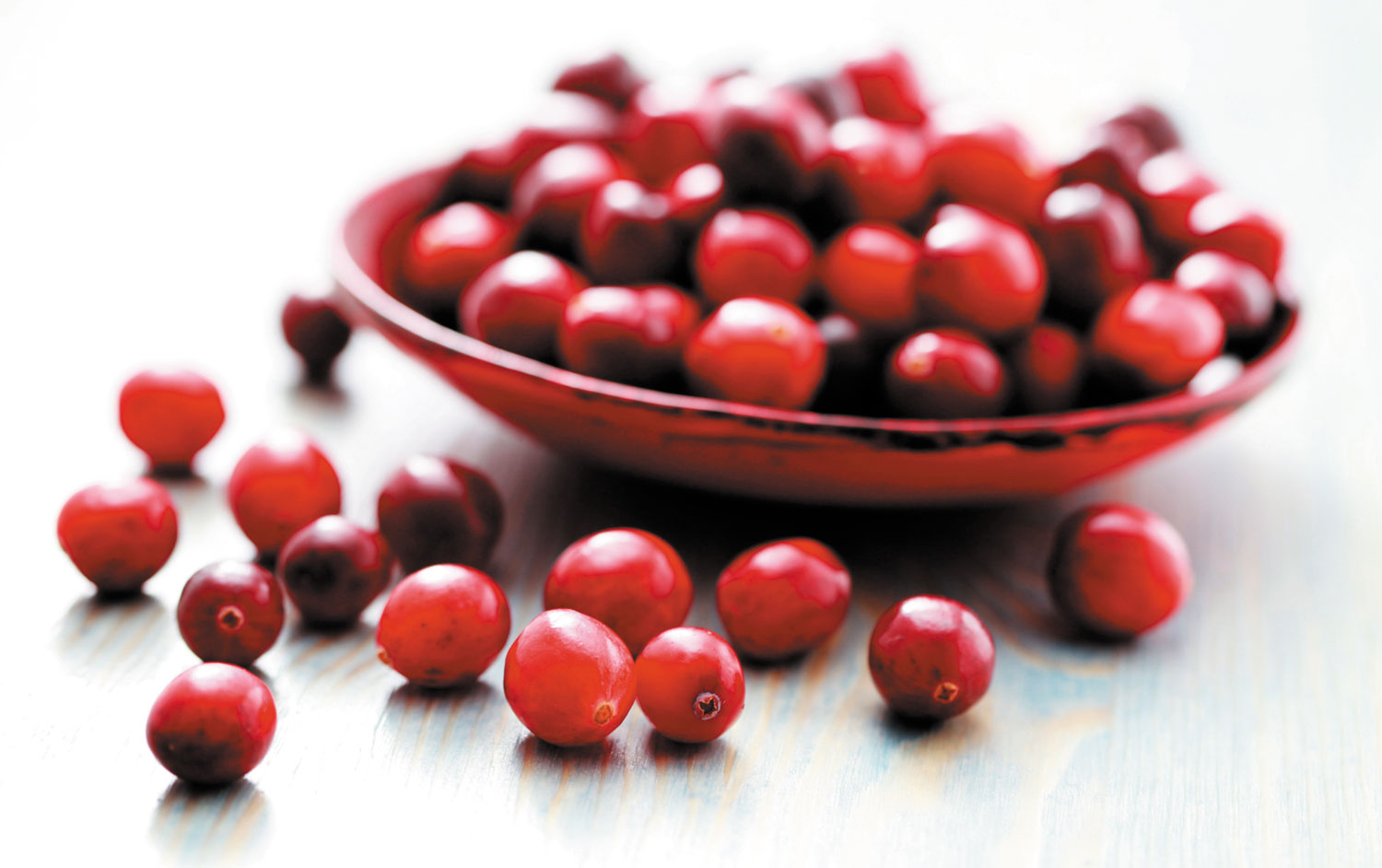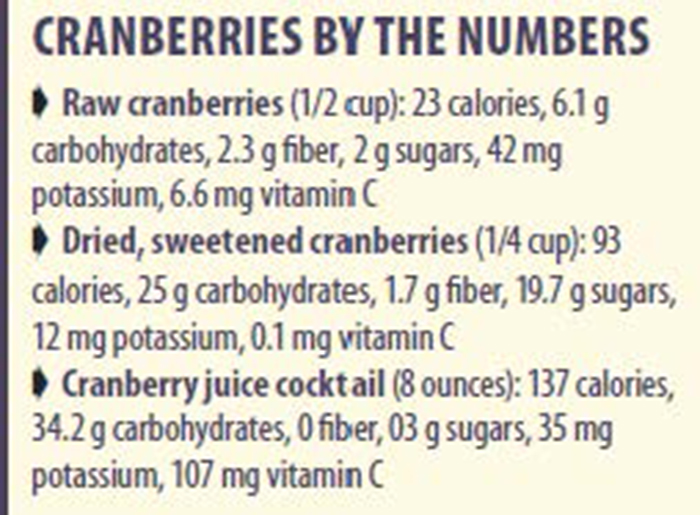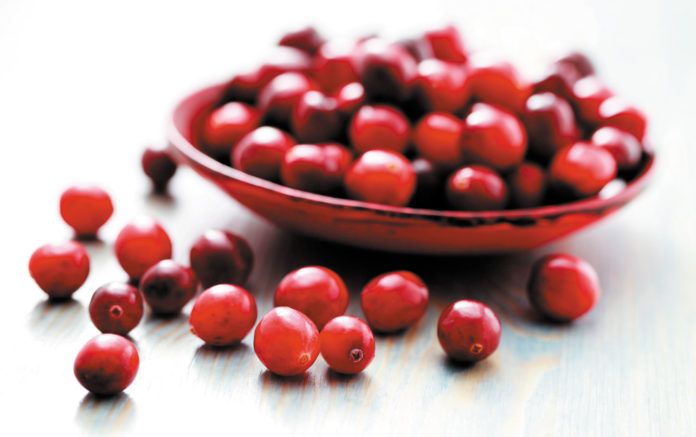If you think of cranberries as strictly Thanksgiving fare, you’re missing out on the unique health benefits of this tart red fruit. “The profile of cranberries’ biologically active constituents is distinct from that of other berry fruit,” says Jeffrey B. Blumberg, PhD, director of Tufts’ HNRCA Antioxidants Research Laboratory. Blumberg and colleagues recently authored a comprehensive review of cranberries’ bioactive compounds and their effects on human health, published in Advances in Nutrition.

“Daily consumption of a variety of fruit is necessary to achieve a healthy dietary pattern, meet recommendations for micronutrient intake, and promote the intake of a diversity of phytochemicals,” the review notes. Berry fruits can play an important role in that mix of dietary fruits. And cranberries, because of their rich content of compounds called polyphenols, deserve a place in your diet beyond their annual appearance in jellied form on the Thanksgiving table.
SOUR AND SWEET: The polyphenol compounds in cranberries include remarkably high levels of anthocyanins, which contribute to the berries’ bright red color. Processing, such as in making cranberry juice, does cause some loss of these and other phytochemicals. High heat can also cause damage to beneficial compounds.
“Nonetheless, cranberry juice can still contribute significantly to the intake of these beneficial phytochemicals,” Blumberg says.
The other challenge in getting the health benefits of cranberries is that these compounds, combined with a very low natural sugar content, make cranberries especially tart and astringent. Whether in juice or cranberry sauce, that means adding sugar. But, Blumberg and colleagues note, the total sugar content of cranberry juice is still comparable to that of grape, apple and orange juice.
Moreover, these experts say, the latest federal dietary guidelines suggest that “the best use of calories from added sweeteners is to increase the palatability of nutrient-dense foods, e.g., the addition of sugar to fruit.” You can also opt for low-calorie versions of cranberry products made with artificial sweeteners.

THE EVIDENCE ON UTIs: In terms of health benefits, cranberries are probably best known for their benefits against urinary tract infections (UTIs).
Several studies and two meta-analyses have supported the effectiveness of this long-standing folk remedy. It’s speculated that cranberry compounds might interfere with how bacteria adhere to the urinary tract, Blumberg says, and perhaps also by modifying the gut microbiota to contain fewer that cause UTIs, though this has yet to be tested in a clinical trial. But other studies have failed to find a link between cranberry intake and reduced UTI recurrence.
“This reveals the complexity in studying the relation between cranberry consumption and health outcomes,” Blumberg observes. “Specifically, interventions testing the efficacy of cranberry juice are confounded by poor compliance, dropout rates as high as 50%, and variable doses of bioactives from the use of different products.”
Research on UTIs is also affected by the wide variation in individuals suffering the infections. Older women, sexually active young women and children each represent quite different patient groups.
Despite the mixed results of studies to date, Blumberg and colleagues believe, “Evidence suggesting that cranberries may decrease the recurrence of urinary tract infections is important because a nutritional approach to this condition could lower the use of antibiotic treatment and the consequent development of resistance to these drugs.”
CARDIOVASCULAR BENEFITS: Another promising, if lesser-known, area of research into cranberries’ possible health benefits relates to cardiovascular health. Blumberg and colleagues outline a number of ways in which studies have shown cranberries might protect the heart and blood vessels, including:
– Reducing bad LDL cholesterol and increasing good HDL cholesterol
– Combating oxidative stress, which contributes to atherosclerosis
– Decreasing inflammation and concentrations of inflammatory compounds
– Improving the function of the lining of blood vessels and increasing levels of nitric oxide, which dilates blood vessels
– Reducing arterial stiffness.
“A growing body of clinical research has examined whether cranberry compounds may lower the risk of cardiovascular disease by affecting multiple risk factors,” says Blumberg. “These studies have used doses that are achievable with daily consumption of most cranberry products. One to two 240-milliliter glasses (8-16 ounces) of cranberry juice cocktail (27% juice) would provide a dose of cranberry juice that is equivalent or greater than the doses examined in clinical studies to date.”
More important, though, is the role cranberries can play in combination with other berries – which also have unique health benefits – in boosting the daily intake of fruits. Says Blumberg, “Choosing a broad array of types of fruit, including berry fruit, will help increase your intake of these bioactive compounds.”





















